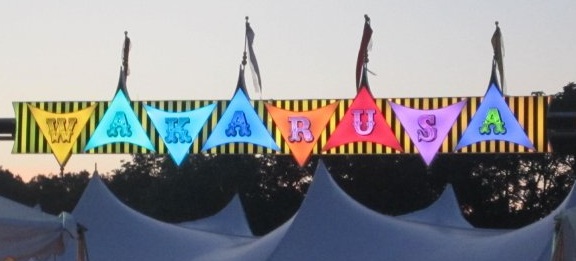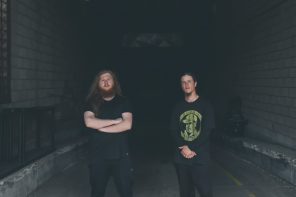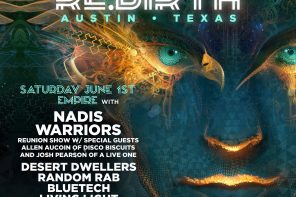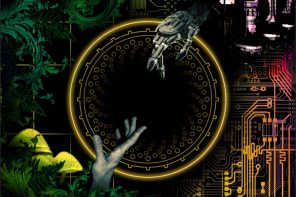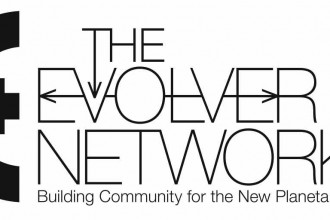What made Wakarusa so special this year is something completely intangible. It wasn’t the mindblowing lineup, sophisticated synthesis of genres, pure beauty of Mulberry Mountain, or hidden waterfall (which looked and felt straight out of Peter Pan’s Neverland, complete with fairies, mermaids and Indians). All of these factors certainly contributed to Waka’s unique brilliance, but at the heart of it all, what really made it special was the intention of this gathering; the common desire shared by festival organizers, vendors, artists, volunteers and patrons alike. The desire to expand our horizons musically, visually, and personally through sharing our art, our food, our music, our rage gear, our bugspray- everything was shared, everyone was cared for by friends (who, in the outside world, might be considered strangers). Wakarusa felt like we were all coming home. Not to a physical place, but to a God-given birthright of acceptance, expression, enjoyment, astonishment, pure love and bliss.
Many festivals are profit-driven by the people who run them and those who show up just to hustle the crowd. It creates an environment where consideration is lacking and some people are so gone its frightening. Wakarusa, like any other festival, had some of this underbelly of the heady culture- but it was insignificant compared to the amount of people who were there simply to love, share, enjoy, learn, witness and experience.
This was reflected through the incredible amount of people who showed up for yoga at 8:30 AM every morning; breathing together, stretching together, saluting the sun, the sky, the earth, channeling animals and flying around like birds while others floated like dandelion fluffs. “We are all trying to go into the light”, said the divine goddess of a yoga teacher, Alice Steuerwald. “It can get muddy down here, sometimes we get stuck. Keep reaching up towards the light.” The yoga classes were held at the Satellite Stage, home of the Interstellar Meltdown, the late night sets. Yoga started immediately after the music ended, and part of the beauty of Wakarusa was the ease with which people transitioned from a raging sunrise electro dance party to inward focus through pranayama (the yoga of breath).
The bridge built by electronic music to other mediums of consciousness expansion was definitely a highlight of the festival. Many other gateways were provided at Waka besides the music- most notably, an experience called “Brainquility: A Digital Meditation“. This took place under a huge canopy surrounded by blacklight paintings, hosting a dozen recliner chairs in a circle, in the middle of which a central computer ran synchronized LED lights & music through goggles and headphones worn by participants. The audio/visual effect encourages Alpha waves, which you experience during REM sleep. This results in a release of DMT caused by lights and music, a legitimate waking dream. You experience a feeling of deep, intense relaxation; a pure beautiful high given to you by your own precious brain.
Another heady component of the cosmic attention intention was Waka’s resident artist, Michael Garfield, who channels sacred geometry and patterns through paint pens, and body paints by donation. His work is multi-dimensional ethereal reflection; like peering into a vortex. His channel to the divine is wide open and clear, much like Alex Grey, and I wouldn’t be surprised if he achieves the same kind of world-renowned respect and affection.
Musically, Wakarusa reached an apex of perfection, fusing the best in old school jamband fan favorites (Widespread Panic, 7 Walkers feat. Bill Kreutzman of the Grateful Dead, Blues Traveler) with cutting edge electronica such as Tipper, Mimosa, and Bluetech. The orgasmic fusion of jam and electronica was skillfully crafted through a wide range of old and new, and with acts who fuse organic instrumentation with electronic ingenuity (such as Big Gigantic, BoomBox, Giant Panda Guerilla Dub Squad and EOTO).
The layout of Wakarusa was pretty ideal, with campgrounds bordering the main stage, a rainbow piano with a self explanatory “Meet Me at The Piano” painted in rambling letters, a spacious vending area and equally-sized shakedown street (affectionately named after the Grateful Dead song, unofficial vendors form a long line resembling a street), and a carnival in between the Outpost Stage & Revival Tent. The giant sparkling ferris wheel and spinning mushroom tops were a welcome spectacle, and the waterslide was much appreciated in the 100+ degree heat. Outside the carnival, a vendor titled “Mystical Toyz” sold fire performance gear and offered incredible shows throughout the night. Even the vendors had amazing range, from the most sophisticated handmade couture leather wear to propane tank drums (imitation Hang drums) to cheap flashing glowing spinning rage toys.
Unfortunately, corporate sponsorships imposed an almost overwhelming presence. There was a giant Camel cigarettes showcase inside a brightly colored, air conditioned trailer, with people standing outside encouraging everyone to try the free Camel Snus. Red Bull hosted the VIP tent and Satellite stage, with a huge logo adorning the DJ booth front and center. Coca-Cola had the most imposing presence of all; a gigantic tent, pretty girls balancing trays of Coke Zero, walking through the crowd, inviting people to try it, and free samples of Coke at the security checkpoints. For a festival with such a positive intention, the presence of free tobacco and soda seemed an extremely contradictory choice (although, with the expense of such a major event, I’m sure it’s hard to turn down corporate sponsorship deals from such monstrous companies). Still, it was definitely a sell-out move… hopefully, next year, Wakarusa will take a page out of Rothbury‘s book and get sponsored by companies such as Clif Bars and Sweet Leaf Tea (healthy products which actually contribute to the well being of people walking, dancing and raging in the heat for 3 days).
However, there was one sponsor this year who’s prominent presence was much appreciated and enjoyed by all: Grassroots California, the fitted hat & clothing company that has experienced an incredible amount of growth and popularity in the last year. Their booth was the center of the vending vortex, blasting beats and featuring the official Wakarusa fitted hat, along with other awesome merchandise. What makes Grassroots California special is their commitment to giving back. A percentage of the proceeds from every product goes to a different charity or organization. Their slogan, “It’s a Movement”, perfectly encapsulates their vision of creating “a company that gives back to the communities we live in, and around the globe.” Ranchsauce and I got a chance to sit down with the CEO of Grassroots California, Ryan Connolly a.k.a Ruga Cons, and ask him some questions about his company, their involvement with Waka, and his take on the scene.
(Questions by Ranch)
How did you come to work on Wakarusa, and is this the first festival you’ve sponsored?
Ruga Cons: We made a hat for Carribean Holidaze, which is a festival with Cloud 9 Productions, who also does Jam Cruise, but this is only the second festival we’ve even vended at. We’ve only been around for a year. Last year I was vending out of my backpack, and this year we’re sponsors. It’s really awesome. People have been coming up to the booth saying “we’ve seen your logo everywhere”, and “great job branding and marketing”, so I definitely think it’s helped us get the word out in a positive way. I think sponsorship is great, especially with the Interstellar Meltdown- it was so pinpoint, specifically geared towards our fans, the fans who know us because we make the hats for their favorite bands. For them to see our logo everywhere, and for us to be able to advertise online, it really brings the community tighter so everyone can relate better. After Summer Camp, and now Wakarusa, I plan on being involved with festivals for a long time.
Your slogan is “It’s a Movement.” What is the movement towards?
RC: I’ll start at the beginning. I worked in finance for three years, and the second I could quit my job to start Grassroots, I did. It started with a documentary I was working on about the California cannabis culture, and after briefly working on it for just about a month, our camera guy got attacked by some dude on meth, and he broke our camera equipment. Part of the movie was about the jobs within jobs in the cannabis culture, how you don’t need to be growing marijuana or selling marijuana to make money in the industry… how I can start a clothing line within the business and make a living off it. That’s how we got started, by selling our merch in dispensaries. And everything we do, we give back a percentage of the proceeds to a charity or organization. Our first charity/organization we worked with was Marijuana Law Reform. After the success we had off just one hat, many bands I was friends with at school wanted hats from us, so instead of just giving back to Marijuana Law Reform, we came up with the idea that there are so many other movements out there that need to get their message across, and what better way to do it than involving music, art and different cultures, and combine it all into a clothing line. So we give the customer three options to pay for any of our products on the website. The more the customer pays, the more we give back to the charity. Up to 30% of the purchase price goes back. It encourages the customer to pay more, to donate more. Right now, we work with NORML, All is One which helps kids in Sierra Leone, Make it Right which is Sound Tribe’s foundation, which builds houses in New Orleans, and the list goes on and on. Basically, with our forces brought together, we can make change happen. I think with art, we can promote change. I think a lot of people overlook the music scene as something where all you do is party, but really, we can party and make a difference at the same time, so we’re trying to spread that message.
What factors do you think led to this sold out festival, doubling the attendance from last year?
RC: Well, in my opinion, Wakarusa had the best lineup this year, which is why we chose this one to do our sponsorship for. We really felt in touch with the music that was gonna be here, since we do a lot of merchandising for some of the bands on the lineup. So in my opinion, its cause the lineup was really sweet, and also because Rothbury’s not around- a lot of people are throwing Rothbury in the mix with why some of these other festivals are doing so well. I think Summer Camp had 4 or 5,000 more people this year than they did last year, so I think it’s gonna be a good summer for music.
What exactly was the role you played this year in production?
RC: Grassroots California sponsored the Interstellar Meltdown, which were all the late night shows. We sponsored the Satellite Stage, the Outpost Stage… I didnt really have any say in who was playing there, but the reason I sponsored it is because a lot of bands we work with were in Interstellar Meltdown, so it made sense.
What bands at Wakarusa do you work with and in what way?
RC: Big Gigantic, Bassnectar, EOTO, Lotus, STS9….mostly, we make their fitted hats.
Insterstellar Meltdown was described as a festival within a festival. What does that mean?
RC: What really makes Wakarusa pretty cool is that you get to see, like, Widespread Panic… and then you get to see Mimosa at Interstellar Meltdown. So it caters to multiple genres, and I really like how [Interstellar Meltdown] was all the late night shows, and they don’t charge you for an extra ticket- not like Summer Camp. Here, anyone can go see the late night sets. I really like the vibe, and it seemed like they had a great production going on with all the lasers and lightshows, so yeah, it’s a lot of fun.
How do you think electronic music’s growing popularity has changed the American festival scene?
RC: I think it’s a force to be reckoned with. You can’t ignore it. You get a lot of haters on it… we ran into some kids yesterday saying “all they have to do is press play”, but really, most of those people don’t know what they’re talking about. If they ever tried any of the programs, they’d see that really, you’re playing multiple instruments at the same time and it takes a lot of talent to produce.

